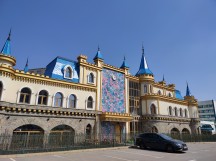Realme 6 Pro review

A total of six cameras
The Realme 6 Pro is big on camera hardware, that's for sure. It's got a quad-camera configuration on the back, and a dual selfie setup and a lot of those modules are shared with the higher-end phones in the lineup.

The primary cam is a 64MP unit with a Quad Bayer filter array - a fairly standard solution for mid-to-high tier smartphones nowadays. The imager is a large Type 1/1.72" one with 0.8µm individual pixels grouped into fours to make up 16 million 'virtual' 1.6µm pixels. The lens in front has a 26mm equivalent focal length and an f/1.8 aperture, but it isn't stabilized - few of the 64MP cams on the market are. Autofocus is handled by phase detection.
The ultra wide-angle camera is shared with the other Realme Sixes - a fairly modest 8MP sensor coupled with what Realme specifies as a 15.7mm lens that covers a 119-degree field of view. The two numbers are incompatible, however. At this sensor size, a 15.7mm lens should cover a diagonal FoV of 108 degrees while it would take a 12.7mm equivalent lens to cover the 119 FoV. Looking at the images, we're inclined to believe the specified millimeters and not the degrees - it's not that wide.
Then there's the telephoto, the one that sets the Realme 6 Pro apart from the 6, and brings it closer to the big boys in the roster. It uses a 12MP 1/3.4" sensor with 1.0µm pixels behind a 54mm equivalent lens with an f/2.5 aperture. This one too lacks stabilization.
The list of cameras on the back ends with a 2MP 'macro' camera.

There are two more cameras on the front - yes, two. A primary cam is a 16MP unit with a 'regular' wide 26mm equivalent lens and an f/2.1 aperture. But there's an extra ultra-wide module with a 17mm lens and an 8MP sensor - that one will fit more people in the frame or better contextualize your lonely selfies.

The camera app is the familiar Oppo/Realme one with a few tweaks here for the latest version. There are fewer menus - most of the modes are now on the main rolodex, which is good. It offers AI scene recognition - you'll see a small icon when a scene is successfully recognized, and the software will tweak all settings accordingly. Food, snow, pets, sunsets, grass, among other scenes, are detected mostly correctly.
The Chroma Boost toggle is on the opposite end of the viewfinder. It's advertised as an advanced HDR mode, which stacks several images and offers even further improvements in the dynamic range and occasionally - higher color saturation. Sometimes too high.
In the Expert mode you get to tweak exposure (ISO in the 100-6400 range and shutter speed in the 1/8000s-2s range, 32s for the telephoto), white balance (by light temperature, but no presets), manual focus (in arbitrary 0 to 1 units with 0 being close focus and 1 being infinity) and exposure compensation (-2EV to +2EV in 1/6EV increments).
You do get to shoot on all three cams in this Expert mode, but switching them is handled in a truly bizarre way. You get the familiar 1x-2x-5x selector, but that doesn't operate the actual cameras - it's a digital zoom from whichever camera you've picked from the tree selector on the opposite end of the viewfinder. Indeed, the trees switch cameras and once you select a module from there, no focusing distance considerations will auto-switch it - that's good.
That, by the way, is how the app will operate in the auto Photo mode - it won't switch to the main cam if you're using the tele, but you try to focus too close. Instead, it the tele viewfinder greets you with a balloon warning to stay 30cm or more from your subject.
Image quality
Image quality from the Realme 6 Pro's main camera is very good. It surpasses that of the Realme 6, which is a welcome sight given the 30% or so price premium you need to pay to go Pro. Could the different chipset finally be making a case for itself? The 6 Pro resolves finer detail and textures and renders foliage in a much more pleasing way. Noise performance is about the same on both - there is some noise, but it's kept low.
The 6 Pro also has livelier colors, next to the more restrained 6, and while we can't say one is bad, the Pro's more vivid approach tends to appeal to us more. The 6 Pro's images have a wider dynamic range than the 6's, but it's also excellent when taken in isolation or in comparison to higher-end models.
Here are a couple of comparison shots taken with the Chroma boost toggle engaged. As you can see, there isn't a world of a difference.



Daylight samples, main camera, Chroma boost on
Shooting at the nominal 64MP resolution will net you some extra detail under the right conditions - a lot of light being a key part. Even so, there's a significant price to be paid in terms of noise - full-res shots have a lot of it. We'd stick to the 16MP default mode.



Daylight samples, main camera, 64MP
The ultra wide-angle cam has half that, but even so it captures good detail plus it has a wide dynamic range as these cameras go. Its photos are on the noisy side of average, however, even in bright daylight at base ISO, and its lens is prone to strong purple fringing.









Daylight samples, ultra wide angle camera
The 6 Pro is one of few Realme phones with a telephoto camera. At 2x zoom, we see some noisy but detailed images. A comparison to a crop of one of the 64MP images from the main cam at 1:1, reveals more detail and better noise performance from the zoom module, so it makes a good case for its existence.









Daylight samples, telephoto camera (2x)
A 5x toggle is also present in the viewfinder, and that does digital zoom from the 2x module. Images look okay at fit to screen magnifications but don't stand up well to pixel-level scrutiny.



Daylight samples, telephoto camera (5x)
The Pro performs better than the non-Pro in low light as well. Images from its main cam manage to hold on to detail and color in a way that the 6's couldn't. The dynamic range is also superior and quite good. Noise is, naturally, part of the picture, but it's to be expected in these circumstances.




Low-light samples, main camera
Night mode brings a boost in the dark shadows and lower midtones and improves highlight retention - just as it should be. While it does reveal more in the tonal extremes, it also means sacrifices in absolute sharpness.




Low-light samples, main camera, Night mode
The seemingly identical ultra wide-angle camera of the 6 Pro takes markedly better pictures in low light when compared to the 6's. That's not to say they're good, strictly speaking - it still underexposes badly in very dark conditions but does keep it together and retains some level of detail and color.




Low-light samples, ultra wide angle camera
Night mode offers some improvements in highlight retention and overall dynamic range, but it's still just a barely usable photo.




Low-light samples, ultra wide angle camera, Night mode
In low light, the Realme 6 Pro doesn't default to the main cam when shooting at 2x zoom, as many previous telephoto camera implementations used to. We'd say these images are one better than the ultra wides. The tele cam does have some issues focusing in low light, and you might need to tap to focus and even then take several shots just in case, but overall it's quite a respectable performance.




Low-light samples, telephoto camera (2x)
Night mode on the tele camera will deliver a much better-looking thumbnail in terms of tonal development and that will comparison will remain true in fit to screen magnifications. On a pixel level, you can expect a softer image.




Low-light samples, telephoto camera (2x), Night mode
Portraits
The Realmi 6 Pro takes portraits with its primary cam only - no 2x telephoto portraits. That comes in handy when reviewing phones in isolation as you can take reasonably well-framed shots of yourself with a 26mm cam at arm's length. More importantly, it also ensures you get better image quality across a wider range of lighting conditions as the main cam's bigger sensor and brighter lens can capture more light. On the flip side, if taking photos of someone else, the longer lens gives a more comfortable working distance, plus it makes for a more flattering perspective.
Anyway, the 6 Pro's portraits are excellent in terms of subject separation. Naturally, messier hair will result in imperfections, but hardly any portrait mode can deal with that.
Close-ups
The dedicated 'macro' camera is more for upping the camera count on the back than for taking photos. Here are a couple of samples to illustrate its poor noise performance, limited dynamic range and not particularly saturated colors. And as for the actual captured detail, you're better off using the main camera.
Selfies
Selfies out of the Realme 6 Pro's main front cam come out really nice in well-lit balanced scenes. In lower light, it may drop the shutter speed below what it safe for a relatively moving subject such as yourself, and you may get some motion blur - try and take multiple shots to make sure you end up with a sharp image. Additionally, the HDR processing is capable of killing finer detail, as evidenced by shots 2 and 4 below. The color rendition is a bit on the reddish side, but this particular subject says he doesn't find it objectionable.




Selfie samples, primary camera
The ultra-wide selfie cam has an entirely different look, and we mean outside of the obvious change in perspective. Contrast is higher, dynamic range is narrower, colors are... different. We enjoy it for the coverage, but we could use some more consistency between the modules.




Selfie samples, ultra wide angle camera
Selfie portraits out of the Realme 6 Pro are okay. Looking up close, you'll see a prevalent loss of fine detail, similar to what we saw in HDR shots in Photo mode. On a positive note, subject isolation is quite good, and if you have any semblance of order in your hairstyle, you can expect great results.
Video recording
The Realme 6 Pro records video at up to 2160p with its main and telephoto cameras, which can also record 1080p at both 30fps and 60fps. The ultra wide-angle cam tops out at 1080p/30fps. You get to pick between the h.264 and h.265 codecs too.
The main camera captures well detailed but oversharpened 4K footage (50Mbps bit rate), which is also somewhat grainy. Colors are pleasingly saturated without going to extremes, and the dynamic range is nicely wide as well. All this holds true for 1080p/30fps videos, too (20Mbps). 1080p/60fps comes with a significant sharpness penalty, which isn't a surprise given that it gets the same bitrate as 1080p/30fps for twice the number of frames. It's also a little warmer, for whatever reason.
It's worth pointing out here that all three of the above modes come with different coverage. 4K uses the entire width of the sensor, 1080p/30fps introduces a significant crop (roughly 1.3x), while 1080p/60fps crops in even further (about 1.45x).
The ultra wide-angle cam's 1080p/30fps footage is decent but inferior to the main cam's in both detail and dynamic range.
The telephoto camera captures quite good footage at 2x zoom with both 4K and 1080p/30fps clips having a lot of detail. 1080p/60fps is once again softer and warmer. The difference in coverage we observed on the main cam continues into 2x zoom - perhaps logically so. We hit the 5x toggle too because it was there, but the results are soft and blotchy and not really usable.
Stabilization is available in 1080p at both frame rates, and it can't be turned off. There's no stabilization in 4K. That does, in a way, explain the difference in coverage between 4K and 1080p, though the further corp in 1080p/60fps must be due to other reasons.
Anyway, walking and shooting in 4K results in very jittery footage so you wouldn't want to do that. Meanwhile, both 30fps and 60fps videos in 1080p from the main cam are well stabilized. The same goes for the ultra wide's 1080p capture on a global scale, though there are local imperfections - wobbly areas here and there.
There's also a two-tiered Ultra Steady mode you engage with a toggle in the viewfinder. In its 'base' mode, it uses the main cam while flipping a second toggle into Max mode engages the ultra wide-angle shooter. We found the results obtained this way to be inferior to what you'd get without Ultra Steady.
The Realme 6 Pro's seemingly competent selfie cam hardware might have you believe it's got some selfie video prowess beyond the usual, but that's not strictly the case. Video resolution is capped at 1080p on both the primary and the ultra-wide front cams, and that's at 30fps - there's no 60fps mode.
Having said that, few phones have an ultra-wide selfie cam, and that does deliver more coverage for when you can get together with your friends or for putting more of a situational context in your selfie videos. However, videos aren't quite as wide as photos because there's a moderate crop applied for the stabilization, which is always on, again. Ultra Steady mode is available too, and here it comes in just one flavor (there's no Max) utilizing the same ultra-wide cam - again, we can't say it's better than the regular ultra-wide stabilization.
As in selfie stills, selfie videos out of the ultra wide-angle cam have a different color reproduction and a narrower dynamic range than ones from the main shooter.
Speaking of, through the magic of default modes, we've shot the main cam in 720p only with no option to reshoot before publishing this review. We'll update with new samples when the stars align. What we can tell from the 720p clip is that it's decently stable and has better skin tones than the other cam's video.
Reader comments
- Mike
- 22 Sep 2024
- 7XH
Camera is defined not poor, the camera has a lot of features that you'll only get in a flagship phone, like a telephoto lens, ultra wide, and an ultra wide selfie camera? Never heard of a phone which has an ultra wide lens in the selfie camera
- Gwagon60
- 30 Oct 2023
- XA7
It's quite surprising that a phone like this never got almost absolute reviews. I have had this phone for 3 years and have not yet found realme product that supercedes this 6 except for their camera outputs. All upgrades have successfully corre...
- AnonD-758491
- 11 Aug 2023
- yZw
Hello GSMArena team! As soon as I've seen review points of Realme 6 Pro today, I'm shocked to see the results! How it's possible that review points can be come down from high degree to lower. It's review points came down fro...




























